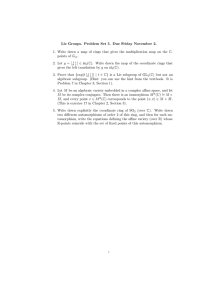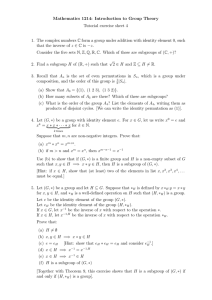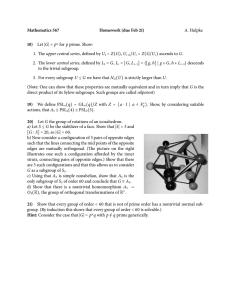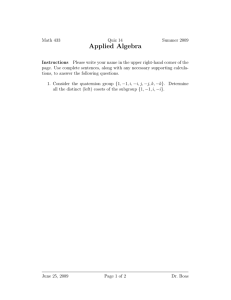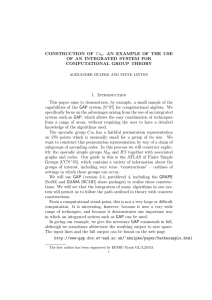o =
advertisement
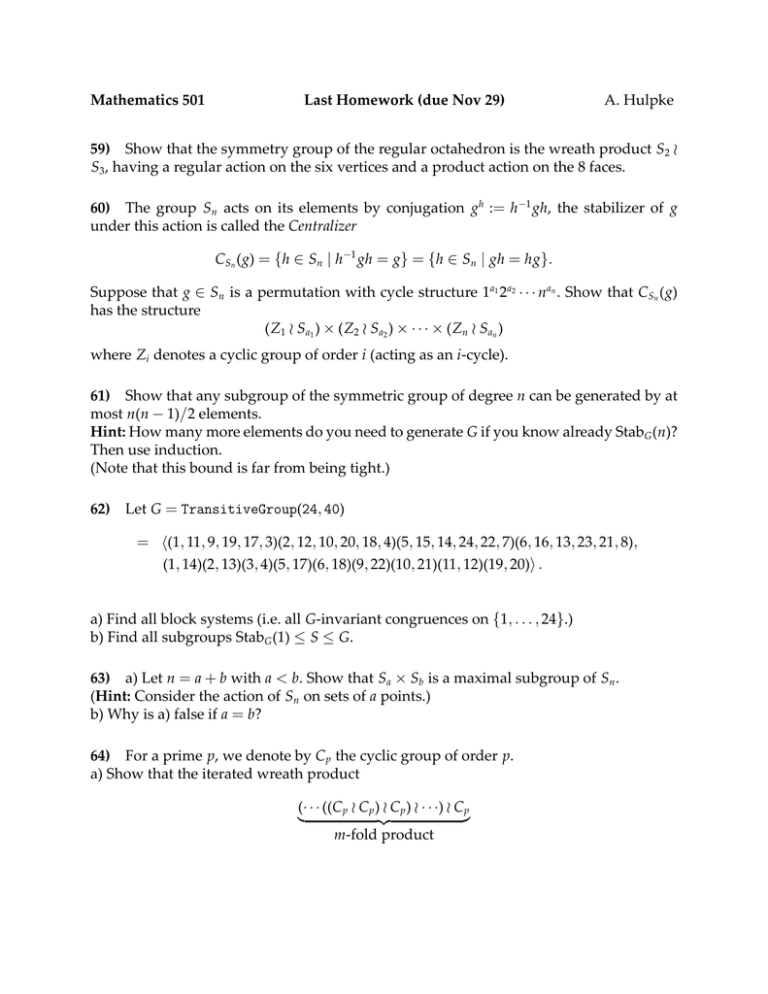
Mathematics 501
Last Homework (due Nov 29)
A. Hulpke
59) Show that the symmetry group of the regular octahedron is the wreath product S2 o
S3 , having a regular action on the six vertices and a product action on the 8 faces.
60) The group Sn acts on its elements by conjugation gh := h−1 gh, the stabilizer of g
under this action is called the Centralizer
CSn (g) = {h ∈ Sn | h−1 gh = g} = {h ∈ Sn | gh = hg}.
Suppose that g ∈ Sn is a permutation with cycle structure 1a1 2a2 · · · nan . Show that CSn (g)
has the structure
(Z1 o Sa1 ) × (Z2 o Sa2 ) × · · · × (Zn o San )
where Zi denotes a cyclic group of order i (acting as an i-cycle).
61) Show that any subgroup of the symmetric group of degree n can be generated by at
most n(n − 1)/2 elements.
Hint: How many more elements do you need to generate G if you know already StabG (n)?
Then use induction.
(Note that this bound is far from being tight.)
62) Let G = TransitiveGroup(24, 40)
= h(1, 11, 9, 19, 17, 3)(2, 12, 10, 20, 18, 4)(5, 15, 14, 24, 22, 7)(6, 16, 13, 23, 21, 8),
(1, 14)(2, 13)(3, 4)(5, 17)(6, 18)(9, 22)(10, 21)(11, 12)(19, 20)i .
a) Find all block systems (i.e. all G-invariant congruences on {1, . . . , 24}.)
b) Find all subgroups StabG (1) ≤ S ≤ G.
63) a) Let n = a + b with a < b. Show that Sa × Sb is a maximal subgroup of Sn .
(Hint: Consider the action of Sn on sets of a points.)
b) Why is a) false if a = b?
64) For a prime p, we denote by Cp the cyclic group of order p.
a) Show that the iterated wreath product
(· · · ((Cp o Cp ) o Cp ) o · · ·) o Cp
{z
}
|
m-fold product
(i.e. for m = 1, we get Cp , for m = 2 Cp o Cp &c.) can be represented by permutations on pm
2
m−1
points and show that its order is p1+ p+ p +···+ p .
b) Let n be a natural number and k = log p (n). Consider n written as a sum of p-powers
k
n = ∑ ai pi
i=0
Show that the power of p that divides n! is exactly
k
i−1
i=1
j=0
∑ ai · ∑ p j
p
!!
c) (C AUCHY) Show that Sn has a subgroup S ≤ Sn with | S| = pa where pa is the maximal
power of p dividing n!, i.e. n!/ pa is an integer not divisible by p. (In the language of
Group theory such a subgroup is calles a Sylow subgroup.) Describe the structure of this
subgroup S.
Hint: Consider first the case that n is a pure power of p.
65∗ ) Let n = 6. There are 62 = 15 pairs of points which we
can consider as edges in the complete graph. A factor is a set
of 3 disjoint edges. A factorization is a partition of the 15 edges
into five factors.
a) Show that two disjoint factors are contained in a unique
factorization.
b) Show that there are exactly six factorizations. (Compare the
logo for the Combinatorics Seminar shown.)
c) Define an action of S6 on factorizations. This gives a homomorphism S6 → S6 . Show
that it is bijective.
d) Show that the automorphism constructed in c) is an outer automorphism. (Consider
for example the image of (1, 2) under the map).
(We thus conclude that S6 has two nonequivalent transitive permutation actions on 6
points. One can show that this phenomenon is unique to the number 6.)

